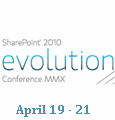8 Things You Should Know About Transactional Processing in SharePoint
 Guest Author: Rutherford Wilson
Guest Author: Rutherford Wilson
SharePoint is making inroads as an ECM or Records Management system, primarily because of its document library features, price, and integration with Office. But, for SharePoint to move beyond that and become the system to do document-centric transactional processing, you’ll need to customize and plan your SharePoint installation more carefully.
1 — Design your Document Taxonomy.
Before you even start using SharePoint for your document-centric workflows, create content types for each type of document, taking care to define the meta-data that must also be captured with this document. Think about the full life-cycle of the document and what data will be needed at each step.
2 — Scan your paper documents into SharePoint.
Many transactions start as paper, so get them into SharePoint as soon as possible. Advanced image processing techniques, such as forms recognition and OMR, can detect the content type and kick off the correct workflow automatically.
3 — Extract information with OCR, barcodes, and manually.
Documents that start as paper need to have their meta-data extracted from the document image that results from the scan. This can be done automatically with OCR and barcodes or manually. Even if it’s done manually, OCR can assist the data entry.
4 – Automate your workflows as much as possible.
Building workflows can get complicated very quickly so start with simple processes first. As your workflows become more complex the key is to minimize the need for manual intervention as much as possible.
5 — Use document viewers that are SharePoint-aware.
When you do need view documents in a workflow, use a document viewer that is SharePoint-aware. When you open a file with Office in SharePoint, it knows that the document came from SharePoint and can save modifications and follow your checkout procedure. But, what about other types? There are third-party viewers that are SharePoint-aware, or even better, are integrated right into SharePoint’s web interface.
6 — View documents in context.
When working on a document, use viewers that can show you more than just the document. To efficiently work on a document you need to see its meta-data, its location in SharePoint, and any outstanding workflows.
7 — Use side by side comparison.
Many transactional workflows need to view two documents at the same time. For example, in accounts payable, you need to see the invoice and the purchase order simultaneously in order to pay the bill. Use document viewers that can support side-by-side viewing with some kind of page synchronization.
8 — Plan for Archiving and Retention.
The full lifecycle of a document includes its transition into a record. Design your content-types so that different policies are represented in the documents meta-data and use workflows to trigger the transition automatically.
This article was originally posted on AIIM President John Mancini’s Digital Landfill blog which contains links to many other “8 things” articles. Some of the 8 things articles have been published as a series of free e-books, available at http://www.aiim.org/8things.
 Guest Author: Rutherford Wilson
Guest Author: Rutherford Wilson
Rutherford Wilson is the VP of Application Product Strategy at Atalasoft. Atalasoft publishes Vizit, the Document Viewer for SharePoint and DotImage, a .NET Imaging SDK. He can be reached via email at [email protected] or on Twitter (@rutherfordw).
- 8 Things You Need to Know about SharePoint Governance
- 8 Things SharePoint 2010 Needs to Be a True ECM System
- 8 More Things You Need to Know about SharePoint
- 8 Things to Consider when Implementing SharePoint with Another ECM engine
- 8 Ways to Use SharePoint for Social Computing
- 8 Reasons You Should Consider Automatic Classification and Automatic Metadata Tagging in SharePoint
- 8 Ways SharePoint Helps in Enterprise Governance, Risk and Compliance
- 8 Things to do to Make Content More Findable in SharePoint
- 8 things to consider when choosing an application to scan and capture documents to SharePoint
- 8 Things You Should Know About Transactional Processing in SharePoint





Fantastic overview.
Nice Records Management overview, but it doesn’t reflect the title (Transactional ??)